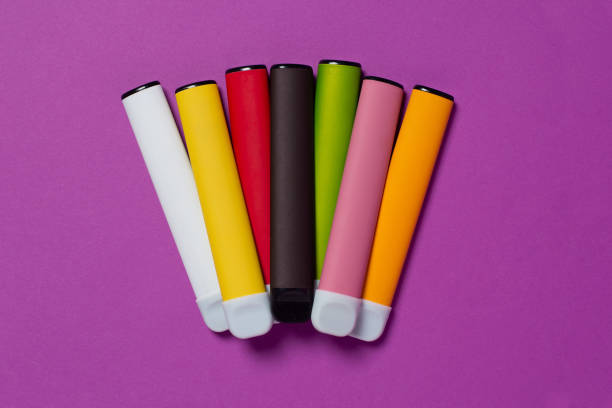
Kid-friendly flavored e-cigarettes/vapes are still widely available online and in stores, despite a federal judge's ruling that should have pulled the products off store shelves by early September, a new report shows.
The judge's ruling follows on U.S. Food and Drug Administration action that is nearly two years old.
Citing risks to vulnerable children, the FDA first announced in January 2020 that "companies that do not cease manufacture, distribution and sale of unauthorized flavored cartridge-based e-cigarettes [other than tobacco or menthol] within 30 days risk FDA enforcement actions."
That was then, this is now, critics say.
Today, more than 100 flavored vaping products with enticing flavors like Gummy Bear, Funnel Cake, Fruit Punch, Berry Crunch Cereal and Blueberry Lemonade are still sold through the five top online e-cigarette retailers, the Campaign for Tobacco-Free Kids report found.
Flavored vapes also were widely available in convenience stores and gas stations located in eight cities across the country, the report added.
"Flavored e-cigarettes of precisely the kind that youth are using are widely available both on the internet and in retail outlets," Matthew Myers, president of the Campaign for Tobacco-Free Kids says.
"Flavors attract them. Nicotine addicts them," Myers continues. "Without the flavors, many fewer kids would be attracted to these products -- 85% of the kids who use an e-cigarette use a flavored one."
A federal court had set a deadline of Sept. 9 for e-cigarette manufacturers to either get U.S. Food and Drug Administration approval for their products or face having them pulled from the market.
Unauthorized e-cigarette products remain on the market months past that deadline, even though they are subject to FDA enforcement action, the report found.
In-store assessments conducted in eight cities found that:
- Juul was sold in all cities, and brands like Vuse, NJOY and blu were available in most.
- Flavored e-liquids were found in most cities, in flavors like Green Apple, Cola, Peachy Rings, Tropical Fruit, Strawberry Macaroon and Island Orange.
- Disposable e-cigarettes were available in every city in flavors like Coconut Pineapple Smoothie, Strawberry Ice Cream, Gummy Bear, Mango Slushee and Blue Razz Lemonade.
The cities included in the survey were Denver; Detroit; Los Angeles; Portland, Maine; Portland, Ore.; Seattle; Tempe, Ariz.; and Washington, DC.
The report helps explain why e-cigarette sales continue to skyrocket in the United States, Myers said.
Sales of disposable e-cigarettes increased by nearly 250% between February 2020 and September 2021, rising from 2.8 million units to 9.6 million units, according to recent sales tracking reported by the CDC Foundation.
Four out of five disposable e-cigarettes sold come in flavors other than tobacco, mint and menthol, the CDC Foundation noted.
Total e-cigarette sales increased by more than 60% during the same period of time (from about 15 million to 24 million units), the CDC Foundation reports. That includes sales of non-tobacco flavored e-cigarettes rising by 86%.
About 1 in every 5 high school seniors have used an e-cigarette within the last month, according to federal survey data cited by Myers.
RELATED: Is There a Link Between Vaping and Eating Disorders in the Young?
FDA yet to act
"That's five times as many kids using e-cigarettes as are using cigarettes," Myers notes.
The FDA says it has acted on more than 98% of the e-cigarette applications it's received, and has issued denial orders for more than 1 million flavored vaping products, the report noted.
However, the agency has dragged its feet in reviewing applications from the e-cigarette manufacturers with the largest market shares, such as Juul, Vuse Alto, NJOY, blu, Smok and Suorin, the report noted.
Until decisions are made on those applications, the FDA has indicated that the products can still be sold. Attempts to reach the agency for comment were unsuccessful.
"It's clear that FDA really needs to quickly act and resolve the remaining applications that it has to go," Erika Sward, assistant vice president of national advocacy for the American Lung Association says. "They've claimed to go through millions of applications, but when you leave the products with the highest market share on the market, it's really only a drop in the bucket."
Sward and Myers suspect the FDA is being cautious and meticulous in reviewing applications from major manufacturers so that its final decisions will hold up in court.
The agency already faces more than 45 lawsuits from companies whose products have been denied, Myers adds.
"Those applications are perhaps more complete and more substantive than a lot of the products from the smaller companies," Sward says of the major e-cigarette brands. "I would also assume FDA is trying to get all of its I's dotted and T's crossed because while some of the smaller manufacturers are suing FDA over marketing denials, they're trying to avoid big lawsuits from the big companies."
The FDA is also grappling with a major loophole that some companies are using to keep selling flavored products.
Puff Bar and other manufacturers have started selling e-cigarettes containing synthetic nicotine. The companies assert that this "tobacco-free nicotine" doesn't fall under the jurisdiction of the FDA's Center for Tobacco Control.
The FDA issued a warning letter against Puff Bar in July 2020, ordering the company to remove its flavored disposable e-cigarettes from the market because they didn't have the required authorization.
In response, Puff Bar re-launched this February with a new synthetic nicotine formula that they claim doesn't fall under the FDA's current rules for vaping products.
Synthetic nicotine a new trick
The agency has said in an online FAQ that it's possible that synthetic nicotine "would not be regulated by the FDA as a tobacco product," adding that it will decide on a case-by-case basis.
However, Sward and Myers believe that the FDA still has approval power over these products. Even if it isn't derived from tobacco, synthetic nicotine remains a new drug that ought to be regulated, they argue.
"It is clear to us that even if the Center for Tobacco Products does not have jurisdiction over these products, the Center for Drug Evaluation can assert jurisdiction over these products as unapproved drugs -- but hasn't," Myers notes.
The way companies have been touting their synthetic nicotine products appears to justify treating the substance as a drug, Linda Richter, PhD, vice president of prevention research and analysis for the Partnership to End Addiction says.
Buyer Beware: FDA Says ‘Wellness’ Vapes Not as Safe as Advertisers’ Claim
"A lot of the companies that are selling these synthetic nicotine products are saying, 'Hey it's purer than nicotine that comes from tobacco, it's got these great ingredients and it's not going to harm you. They're kind of promoting it through health benefits, which puts it under the drug regulation authority of the FDA," Richter points out.
Even better would be for Congress to intervene regarding synthetic nicotine, Myers says.
"The best possible solution would be for Congress to clarify the definition of a tobacco product to specifically include these products," Myers adds. "Otherwise, FDA will be playing whack-a-mole from now to kingdom come."
Overall, the FDA has been timid in the face of continued opposition from the vaping industry, and needs to step up its efforts, according to Myers and Sward.
"They've had more than three months past their deadline from the federal judge to deal with these products, and it's very disheartening that they have not so far," Sward says.
"The clear takeaway is that as long as flavored products are for sale, kids will get them. The only way to protect kids from flavored products is to make it illegal to sell them," she concludes.
However, the FDA might simply be outgunned and overwhelmed, Richter says.
"I just don't know that it has the staff and the funding to keep up with this extremely well-funded industry, especially given that there's plenty of people within the government who don't think the regulations should be as strong as they are," Richter says.
"Then you turn to a product like vaping that is presented as somewhat healthier, so you have a lot of people within Congress and regulators who say, hey, let's be careful how much we restrict those because it might deter people from quitting smoking. That's the murkier landscape that allows a lot of this to go on," Richter concludes.
Prevention tips
The Partnership to End Addiction points out how important to be aware of the available nicotine products and how their manufacturers work around the existing restrictions that seek to protect youth from the harms of tobacco and nicotine. To help prevent your child from using, try the following:
- Be aware and stay up to date on the latest trends in nicotine products, what they look like and how they are used, so that you can know if your child is using them.
- Model healthy behavior for your child by not using or condoning the use of any nicotine products.
- Connect with your child, have honest conversations with them and talk regularly about nicotine, other substances and how using them can damage their health and well-being.
- Clearly convey that you expect them not to use these products, monitor their activities, and intervene when necessary in a health-promoting, rather than in a punitive way.
- Make sure they know they can come to you for help if they are struggling and possibly using nicotine or other substances to cope.
- Know about the factors that can increase your child’s risk of using, such as mental health issues, and address these early with the help of a qualified health professional.









